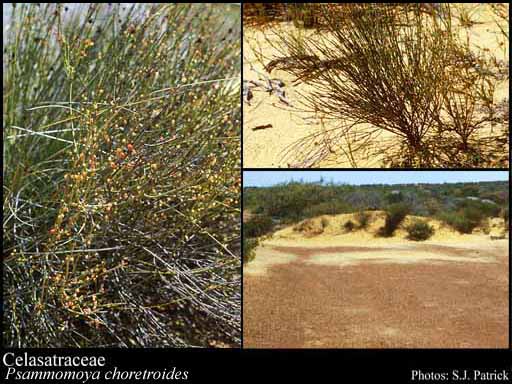- Reference
- Voy.Terra Austral. 2:554 (1814)
- Name Status
- Current

Scientific Description
Common name. Bittersweet Family.
Habit and leaf form. Trees, shrubs, and lianas; laticiferous, or non-laticiferous and without coloured juice. ‘Normal’ plants, or switch-plants (sometimes). Leaves well developed (usually), or much reduced (e.g. Psammomoya). Self supporting, or climbing; when climbing, stem twiners (e.g. Hippocratea). Leaves alternate, or opposite; ‘herbaceous’, or leathery; petiolate; non-sheathing; simple. Leaf blades entire; pinnately veined; cross-venulate. Leaves with stipules (stipules small), or without stipules. Stipules when present, caducous. Leaves without a persistent basal meristem. Domatia recorded (one genus); represented by pits. Stem anatomy. Nodes unilacunar. Secondary thickening developing from a conventional cambial ring, or anomalous; when anomalous, via concentric cambia (e.g. Salacia).
Reproductive type, pollination. Fertile flowers hermaphrodite (usually), or functionally male and functionally female, or functionally male, or functionally female. Unisexual flowers present, or absent. Plants hermaphrodite (usually), or monoecious, or dioecious. Entomophilous.
Inflorescence and flower features. Flowers aggregated in ‘inflorescences’; in cymes, or in fascicles. The terminal inflorescence unit cymose (usually), or racemose (rarely). Inflorescences terminal, or axillary, or epiphyllous (Polycardia); mostly cymes or fascicles. Flowers usually small; regular; 4–5 merous; cyclic; nearly always tetracyclic. Hypogynous disk usually present; intrastaminal; annular. Perianth with distinct calyx and corolla; (4–)8–10; 2 -whorled; isomerous. Calyx (2–)4–5; 1 -whorled; polysepalous, or gamosepalous (basally); entire, or lobed; imbricate, or valvate (rarely); regular. Corolla (2–)4–5; 1 -whorled; polypetalous; imbricate, or valvate; regular. Fertile stamens present (usually), or absent (in functionally female flowers). Androecium (2–)3, or (4–)5. Androecial members free of the perianth; free of one another, or coherent (sometimes connate at the base); when joined 1 - adelphous; 1 -whorled (usually), or 2 -whorled. Androecium exclusively of fertile stamens (usually), or including staminodes. Staminodes sometimes (2–)3–5 (alternating with the stamens). Stamens (2–)3–5; isomerous with the perianth; oppositisepalous. Anthers dehiscing via longitudinal slits; extrorse, or introrse; unilocular to bilocular; bisporangiate, or tetrasporangiate. Pollen shed in aggregates (often), or shed as single grains; when in aggregates in tetrads, or in polyads. Fertile gynoecium present (usually), or absent (in functionally male flowers). Gynoecium 2–5 carpelled (usually with all but one abortive). The pistil 2–5 celled. Gynoecium syncarpous; synstylovarious, or eu-syncarpous; superior, or partly inferior (rarely). Ovary plurilocular; 2–5 locular. Gynoecium non-stylate, or stylate. Styles 1; attenuate from the ovary; apical. Stigmas 1, or 2–5 (same number as G); dry type; non-papillate; Group II type. Placentation axile. Ovules (1–)2 per locule (usually), or 3–50 per locule (rarely many); pendulous, or ascending; apotropous; with ventral raphe, or with dorsal raphe (when pendulous); often arillate; anatropous.
Fruit and seed features. Fruit fleshy, or non-fleshy; dehiscent, or indehiscent; a capsule, or a berry, or a drupe, or a samara, or achene-like. Capsules loculicidal. Seeds endospermic (usually), or non-endospermic. Endosperm when present, ‘more or less’ oily. Seeds winged, or wingless. Embryo well differentiated. Cotyledons 2 (large, flat, foliaceous). Embryo chlorophyllous (3/19); straight. Seedling. Germination phanerocotylar, or cryptocotylar.
Physiology, biochemistry. Aluminium accumulation demonstrated (rarely). Photosynthetic pathway: C3, or CAM.
Geography, cytology, number of species. World distribution: cosmopolitan. 850 species.
Economic uses, etc. A few genera cultivated as ornamentals (e.g. Catha, Celastrus, Elaeodendron, Euonymus).